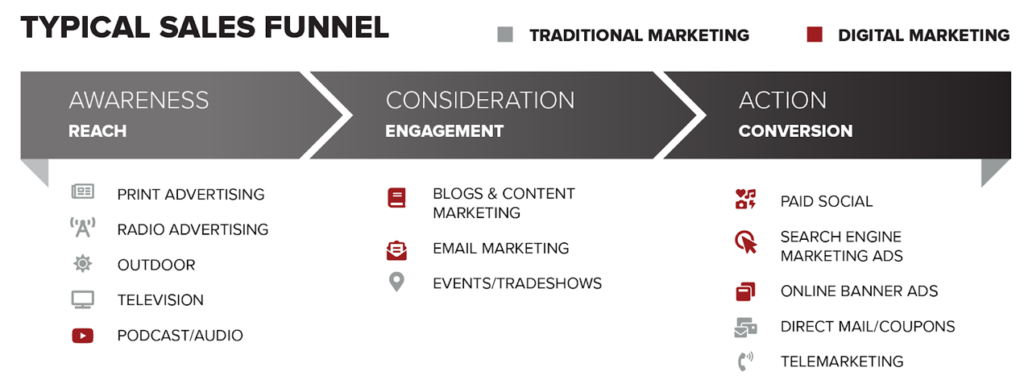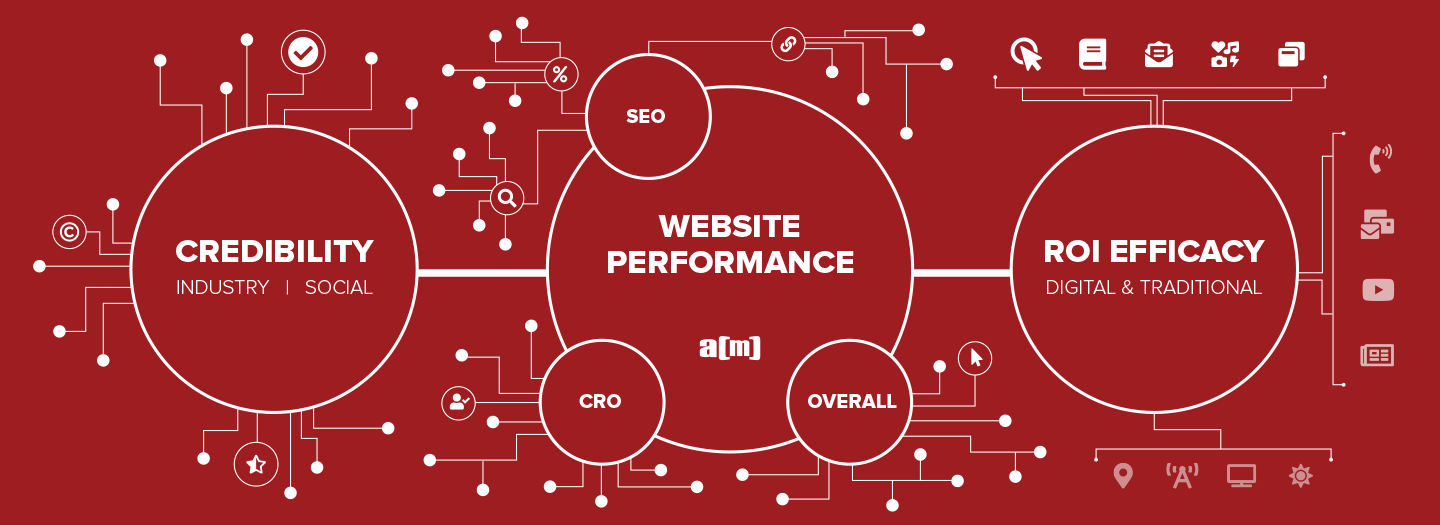The word “audit” has a long history of sounding intimidating and negative. It conjures up images of tax collectors and home appraisers. Instinctively, it makes you want to present your best self so as not to be judged too harshly.
In short, it’s not our favorite word.
But in marketing, we’re always auditing. We’re constantly looking at products and services, grading the presentation and possible audience, and thinking of ways to make them better. Every time you have a new client and you’re learning about their business you’re engaging in some variation of an audit.
Therefore, it makes sense that professional audits are valuable. Getting a third-party perspective on your business can mean fixing things you didn’t know were broken so that you can bring in more customers and increase your profit margin.
As an agency, it’s important to us to have a structure around how we audit our own clients—and our potential clients. A lot of agencies prepare audits that only focus on one area – they look at the website, SEO, social presence, or brand. But not a lot of them offer a holistic look at all of these aspects in relation to your overall business performance. Because while you may have a strong social following, you may not have a website that’s ranking high on SERP (search engine results pages). And that means you’re leaving money on the table.
But what works for one client typically doesn’t work for all clients. Creating this type of audit was going to be difficult. What was the secret formula? What sort of process could we develop that would grade each of our clients fairly and accurately?
With that question in mind, we set out to create an audit that incorporates the most crucial components of marketing in order to deliver actionable recommendations designed to improve a company’s overall business performance.
Website Performance
As a marketing agency that specializes in SEO, we originally wanted to create a simple performance check that would measure SEO techniques and ensure our clients’ websites were well optimized and performing to the best of their ability. But then, Gill Andrew’s came out with a comprehensive checklist for maintaining website credibility and we realized that we could offer more to our clients than a simple report card of collected metrics.
So, we took a step back and looked at what makes a website not just operational—but exceptional. After much research—and a few failed drafts—we determined that there are three key areas that should be reviewed in order to get a complete look at how a business’s website is performing:
- Website User Experience Website credibility guidelines have been relatively unchanged since 2001. As a result, the 10 key elements of website credibility are often taken for granted or altogether overlooked. But they are imperative to building a good user experience. And as marketing experts, it’s our responsibility to make sure that these key elements are factored into your website design and are not forgotten.
- CRO Tactics We often stress to our clients that conversion rate optimization is imperative to their success online—and as you can see from our CRO Library, there are literally dozens of different CRO tests to try and tactics to implement. When utilized correctly, the right CRO tactics for your business will increase your conversion rate and offer a higher marketing ROI. We look at these tactics like the “special sauce” that makes the difference between a Big Mac and a regular hamburger. Your website will never be as good as it could be without them.
- SEO Performance By now, we all know that Search Engine Optimization is the largest factor in what makes one website rank above another. And in the ever-changing landscape of SEO ideas and best practices, it’s never been more important to make sure that your website health is front and center in your marketing strategy.
>> Check out our 13 Best SEO Ideas for 2021 to keep your SEO strategy fresh.
Social Credibility
When businesses first realized that having a Facebook presence could increase their reach with potential customers, they swarmed the platform and became obsessed with building their followers. In some cases, businesses were even willing to pay for these followers via Facebook Page Like campaigns—assuming that they would pay for new audiences that would engage with their business.
But, with the increase in popularity of these paid Page Likes campaigns, came an increase in fake Facebook accounts created for the sole purpose of liking pages and making money. So, while these Page Likes campaigns appeared to bring in more followers, in the end, they just ended up increasing the number of ghost followers – people who would never engage with the business or purchase the product/service.
This is a perfect example of why, as marketers, we concentrate more on the quality of your social presence than the number of followers you have.
Since studies have shown that more than 60% of consumers read customer reviews before they make a purchase, we’re more focused on making sure that your business looks credible for potential customers and that you’re on the right social channels to help you meet your goals and increase your engagement with the right audience.
Marketing ROI
Thankfully, marketing is not a “one size fits all” practice. If it were, agencies would be in serious trouble!
However, the downside of this variability is that it can be almost impossible to create a standard of measurement that accurately determines whether or not a marketing channel will achieve a return on investment for a particular product or service.
But almost impossible is NOT impossible.
As we reviewed dozens of marketing factors across B2B and B2C companies to build our Marketing ROI audit, we kept coming back to four main categories that need to be considered. These became the four pillars we used to measure whether or not ROI is likely for a particular marketing channel:
- Audience + Targeting First and foremost: Who is your audience? Knowing who you’re speaking to is the #1 rule of any marketing and advertising campaign. Determining who your audience is allows you to do the research needed to determine where that audience is, who they interact with, and what they pay attention to—so you can determine what your target for advertising should be. With better ad targeting, you can ensure that you’re speaking directly to the decision-makers, and not waste your time on people who will never purchase your product or service.
- Resources “Who is your audience?” is almost always immediately followed by “what’s your budget?” for one reason: Marketing possibilities may be endless, but cash isn’t. And it’s not just the cost of the marketing channel in question. The time to create and set up ads is sometimes overlooked when creating a marketing plan. But if your main resource—your employees—are spending hours creating an ad or moderating a campaign, that time affects the overall return on investment. So, are television ads effective for building awareness of your product or service? Heck yes. But not everyone has the resources needed, making this a non-viable channel for many small businesses.
- Objective Speaking of television ads… What is your Primary Marketing Objective? If it’s awareness and you have the resources, then TV ads could be for you. But if you want to collect leads for B2B sales—you’re most definitely barking up the wrong tree. Knowing what our client’s Primary Marketing Objective is and where that falls in relation to the Typical Sales Funnel helps us to determine how effective each marketing channel would be. It might be tempting to be on the biggest, most visible channel – and you may be itching to advertise on the hottest, trendiest new social platform. But you should really be focusing on where your marketing message has the best opportunity to help you reach your overall objective.

- Tracking If you can’t track how a campaign is performing, how can you get an accurate assessment of the ROI? The general rule of thumb with most campaigns is that the more digitally focused a marketing channel is, the easier it will be to specify your target, create a customized ad for them, and track how the campaign performs. But we all know by now that Apple recently did a thing that screwed up a lot of tracking abilities for digital marketing campaigns—and most of us are still figuring out how these changes affect our campaign and audience tracking abilities. The truth is, while we all care about privacy, the loss of tracking data from a player as big as Apple is a big change for everyone who engages with the internet—consumers and marketers alike. If it wasn’t such a drastic change to how we go to market, Facebook wouldn’t have launched a massive, somewhat deceptive, campaign against Apple to try to prevent this change from happening. But, since the privacy changes aren’t done yet, it’s our job to figure out other ways to customize experiences and track campaign performance. Because without the ability to track how a campaign is performing, we lose the ability to quickly pivot and redirect our resources to more effective campaigns.
Branding
Now that we’ve gone through your website, reviewed your social presence and analyzed your marketing plans, it felt negligent to not include an overall brand performance review. After all, we have already reviewed a majority of your consumer-facing messages.
By analyzing your brand consistency, we can make sure that all of your messaging is working together to benefit your business. A clear presentation of who you are as a company and what you do helps build social and industry credibility. This is credibility that goes a long way in helping your business perform better.
In the end, our full SEO & Marketing Audit became a behemoth of a document that includes:
- An interactive survey and kickoff call to understand your business goals and objectives—so that we can make sure the audit covers your specific business needs.
- An in-depth review of your Search Engine Optimization practices and detailed recommendations on how to improve your website performance organically.
- A full review of your website to test the user experience.
- Detailed recommendations on how to improve your Website Credibility.
- A review of your website to ensure you’re implementing best practices for Conversion Rate Optimization.
- A complete look at your social credibility—not just your social following, but how your social presence is contributing to, or hurting, your business.
- A review of your current marketing initiatives and recommendations on how to improve your tactics and increase your return on investment.
- A brand marketing analysis that provides insight into your business recognition in the marketplace.
- An accessibility review to check that your website is following common ADA compliance guidelines.
So, how does your website stack up? Get a taste of the full audit with a free preliminary review.
